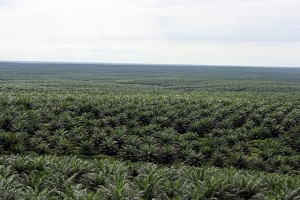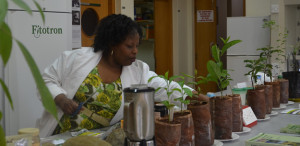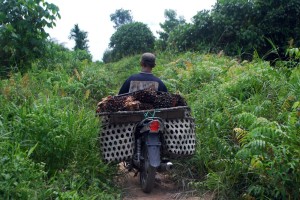By Rob Finlayson, originally posted at Agroforestry World Blog

The idea of creating multiple agricultural alternatives for farmers within oil-palm landscapes has attracted interest from large industry players at a conference in Malaysia, the world’s second-biggest producing nation.
Oil palm (Elaeis guineensis) is one of the most controversial agricultural commodities of our time. To its supporters, it is the ‘golden crop’ that grows smallholders out of poverty and which offers salvation to the global food and energy crisis. For its critics, it is the single biggest driver of the destruction of peatlands and rainforests that accelerates greenhouse-gas emissions, posing a fundamental threat to existence as we know it.
‘Mainly because of consumer concerns, but also because of the realisation that resources are not infinite’, said Faisal Mohd Noor, speaking at the International Palm Oil Congress and Exhibition in Kuala Lumpur in October 2015, ‘the industry is changing’.
Noor, an oil-palm researcher working with the oil-palm sentinel landscape theme of the CGIAR Research Program on Forests, Trees and Agroforestry, met with a warm reception from industry leaders to his research team’s proposal for ‘livelihoods insetting’, which simultaneously addresses consumer concerns about oil-palm sustainability and industry concerns about productivity. ‘Insetting’ involves embedding sustainable activities directly into a business’s supply chain and leads to the build-up of human capital in the communities involved.

Photo: World Agroforestry Centre
A working example of insetting is the African-orphan-crops consortium funded by Mars Inc. Bruno Roche, Mars’ chief economist and Catalyst program managing director, has claimed success for insetting, stating that, ‘We know that investing in the human capital of communities in our sourcing landscapes leads to a higher productivity and profit for us’.
In response to Noor’s presentation, head of certification for the Roundtable on Sustainable Palm Oil (RSPO), Jan van Driel, asked what RSPO could do to help and how it could participate; Faris Adli Shukery, head of marketing with Sime Darby Foods and Beverages, said that the oil-palm industry has been the driving force behind the development of the rural people of Malaysia and Indonesia and livelihood insetting is an interesting concept that would make the contribution of the industry more visible to consumers of palm-oil products.
Speaking on the sidelines after Noor’s presentation, Genting Plantations’ Chew Jit Seng, vice-president for sustainability, stated that insetting was a good idea to pursue, as did International Sustainability and Carbon Certification’s managing director Norbert Schmitz, while the Malaysian Palm Oil Council’s chief executive Dato’ Dr Makhdzir Mardan said it was something to be encouraged with his full support.
‘Insetting isn’t a new idea but is usually only used in the context of mitigating environmental impacts, such as land degradation, biodiversity and climate change. What is new is that we are asking the industry to work together with other partners to set up market structures and functional value chains for other agricultural and forest products’, explained Noor. ‘Put simply, insetting would see the oil-palm industry investing in building alternative agricultural livelihoods’ options for farmers in oil-palm landscapes’.
Research by the World Agroforestry Centre and others has shown that farmers with diverse livelihoods are more resilient towards fluctuating global prices as well as climate shocks. But as well as better serving the smallholding producers of oil palm, insetting also promises to support the main aim of the oil-palm industry.

‘It’s important to note that insetting isn’t simply a different packaging of corporate social responsibility’, continued Noor. ‘It’s actually directly linked to the industry’s core business: increasing productivity. Farmers who are happier and better off are more likely to produce high palm-oil yields than farmers who eke out a marginal existence’.
Diverse agroforestry systems have been proven to broadly improve farmers’ livelihoods unlike monocultural crops that put farmers at the mercy of market and climate fluctuations.
‘The presentation was just an introduction of the concept to industry,’ explained Noor. ‘However, the message is clear that the palm-oil industry must change its strategy. With forward thinking, such as widespread adoption of insetting, the industry can stop being in defensive mode and prove it is really serious about sustainability.
‘But to do that, the industry has to change itself. One of the biggest challenges is how most people in the industry think about agriculture. The concept of mixed crops, or integrated farming, seems to have almost vanished from the mindset of the agriculturalists I spoke with at the conference. So it is critically important to get the industry leaders interested in diversification, produce research that will guide implementation and help them promote it widely amongst all players’.
The situation is critical for governments not only because of the falling revenues from the palm-oil industry but also for the security of incomes and food supply for citizens. Oil palm is not a very suitable crop for smallholders because it requires high upfront investment, is difficult to manage—especially for older people—and needs intensive input to produce high yields. Countries with higher incomes and ageing agricultural workforces, such as Malaysia, are experiencing a critical labour shortage. Malaysia has a high dependency (> 70%) on migrant workers, mainly from Indonesia. Now that Indonesia has become the main palm-oil producer and is offering the same wage levels, most migrant workers have returned to their home country. Addressing the problem through mechanization is not looking plausible owing to only poor-quality machinery being available.
At the same time, for most Indonesian and Malaysian farmers, oil palm has become the only possible use for their land, because there are no, or weak, market structures for other agricultural products.











